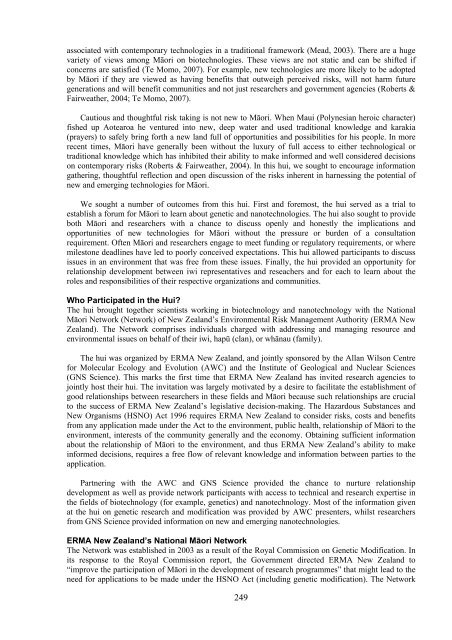traditional knowledge conference 2008 te tatau pounamu
traditional knowledge conference 2008 te tatau pounamu
traditional knowledge conference 2008 te tatau pounamu
You also want an ePaper? Increase the reach of your titles
YUMPU automatically turns print PDFs into web optimized ePapers that Google loves.
associa<strong>te</strong>d with con<strong>te</strong>mporary <strong>te</strong>chnologies in a <strong>traditional</strong> framework (Mead, 2003). There are a hugevariety of views among Māori on bio<strong>te</strong>chnologies. These views are not static and can be shif<strong>te</strong>d ifconcerns are satisfied (Te Momo, 2007). For example, new <strong>te</strong>chnologies are more likely to be adop<strong>te</strong>dby Māori if they are viewed as having benefits that outweigh perceived risks, will not harm futuregenerations and will benefit communities and not just researchers and government agencies (Roberts &Fairweather, 2004; Te Momo, 2007).Cautious and thoughtful risk taking is not new to Māori. When Maui (Polynesian heroic charac<strong>te</strong>r)fished up Ao<strong>te</strong>aroa he ventured into new, deep wa<strong>te</strong>r and used <strong>traditional</strong> <strong>knowledge</strong> and karakia(prayers) to safely bring forth a new land full of opportunities and possibilities for his people. In morerecent times, Māori have generally been without the luxury of full access to either <strong>te</strong>chnological or<strong>traditional</strong> <strong>knowledge</strong> which has inhibi<strong>te</strong>d their ability to make informed and well considered decisionson con<strong>te</strong>mporary risks (Roberts & Fairweather, 2004). In this hui, we sought to encourage informationgathering, thoughtful reflection and open discussion of the risks inherent in harnessing the po<strong>te</strong>ntial ofnew and emerging <strong>te</strong>chnologies for Māori.We sought a number of outcomes from this hui. First and foremost, the hui served as a trial toestablish a forum for Māori to learn about genetic and nano<strong>te</strong>chnologies. The hui also sought to provideboth Māori and researchers with a chance to discuss openly and honestly the implications andopportunities of new <strong>te</strong>chnologies for Māori without the pressure or burden of a consultationrequirement. Of<strong>te</strong>n Māori and researchers engage to meet funding or regulatory requirements, or wheremilestone deadlines have led to poorly conceived expectations. This hui allowed participants to discussissues in an environment that was free from these issues. Finally, the hui provided an opportunity forrelationship development between iwi representatives and reseachers and for each to learn about theroles and responsibilities of their respective organizations and communities.Who Participa<strong>te</strong>d in the Hui?The hui brought together scientists working in bio<strong>te</strong>chnology and nano<strong>te</strong>chnology with the NationalMāori Network (Network) of New Zealand’s Environmental Risk Management Authority (ERMA NewZealand). The Network comprises individuals charged with addressing and managing resource andenvironmental issues on behalf of their iwi, hapū (clan), or whānau (family).The hui was organized by ERMA New Zealand, and jointly sponsored by the Allan Wilson Centrefor Molecular Ecology and Evolution (AWC) and the Institu<strong>te</strong> of Geological and Nuclear Sciences(GNS Science). This marks the first time that ERMA New Zealand has invi<strong>te</strong>d research agencies tojointly host their hui. The invitation was largely motiva<strong>te</strong>d by a desire to facilita<strong>te</strong> the establishment ofgood relationships between researchers in these fields and Māori because such relationships are crucialto the success of ERMA New Zealand’s legislative decision-making. The Hazardous Substances andNew Organisms (HSNO) Act 1996 requires ERMA New Zealand to consider risks, costs and benefitsfrom any application made under the Act to the environment, public health, relationship of Māori to theenvironment, in<strong>te</strong>rests of the community generally and the economy. Obtaining sufficient informationabout the relationship of Māori to the environment, and thus ERMA New Zealand’s ability to makeinformed decisions, requires a free flow of relevant <strong>knowledge</strong> and information between parties to theapplication.Partnering with the AWC and GNS Science provided the chance to nurture relationshipdevelopment as well as provide network participants with access to <strong>te</strong>chnical and research expertise inthe fields of bio<strong>te</strong>chnology (for example, genetics) and nano<strong>te</strong>chnology. Most of the information givenat the hui on genetic research and modification was provided by AWC presen<strong>te</strong>rs, whilst researchersfrom GNS Science provided information on new and emerging nano<strong>te</strong>chnologies.ERMA New Zealand’s National Māori NetworkThe Network was established in 2003 as a result of the Royal Commission on Genetic Modification. Inits response to the Royal Commission report, the Government direc<strong>te</strong>d ERMA New Zealand to“improve the participation of Māori in the development of research programmes” that might lead to theneed for applications to be made under the HSNO Act (including genetic modification). The Network249
















